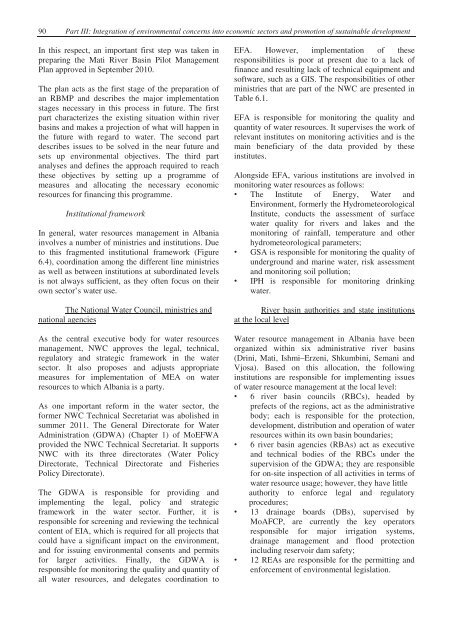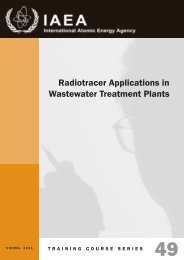Second Environmental Performance Review of Albania
Second Environmental Performance Review of Albania
Second Environmental Performance Review of Albania
You also want an ePaper? Increase the reach of your titles
YUMPU automatically turns print PDFs into web optimized ePapers that Google loves.
90 Part III: Integration <strong>of</strong> environmental concerns into economic sectors and promotion <strong>of</strong> sustainable developmentIn this respect, an important first step was taken inpreparing the Mati River Basin Pilot ManagementPlan approved in September 2010.The plan acts as the first stage <strong>of</strong> the preparation <strong>of</strong>an RBMP and describes the major implementationstages necessary in this process in future. The firstpart characterizes the existing situation within riverbasins and makes a projection <strong>of</strong> what will happen inthe future with regard to water. The second partdescribes issues to be solved in the near future andsets up environmental objectives. The third partanalyses and defines the approach required to reachthese objectives by setting up a programme <strong>of</strong>measures and allocating the necessary economicresources for financing this programme.Institutional frameworkIn general, water resources management in <strong>Albania</strong>involves a number <strong>of</strong> ministries and institutions. Dueto this fragmented institutional framework (Figure6.4), coordination among the different line ministriesas well as between institutions at subordinated levelsis not always sufficient, as they <strong>of</strong>ten focus on theirown sector’s water use.The National Water Council, ministries andnational agenciesAs the central executive body for water resourcesmanagement, NWC approves the legal, technical,regulatory and strategic framework in the watersector. It also proposes and adjusts appropriatemeasures for implementation <strong>of</strong> MEA on waterresources to which <strong>Albania</strong> is a party.As one important reform in the water sector, theformer NWC Technical Secretariat was abolished insummer 2011. The General Directorate for WaterAdministration (GDWA) (Chapter 1) <strong>of</strong> MoEFWAprovided the NWC Technical Secretariat. It supportsNWC with its three directorates (Water PolicyDirectorate, Technical Directorate and FisheriesPolicy Directorate).The GDWA is responsible for providing andimplementing the legal, policy and strategicframework in the water sector. Further, it isresponsible for screening and reviewing the technicalcontent <strong>of</strong> EIA, which is required for all projects thatcould have a significant impact on the environment,and for issuing environmental consents and permitsfor larger activities. Finally, the GDWA isresponsible for monitoring the quality and quantity <strong>of</strong>all water resources, and delegates coordination toEFA. However, implementation <strong>of</strong> theseresponsibilities is poor at present due to a lack <strong>of</strong>finance and resulting lack <strong>of</strong> technical equipment ands<strong>of</strong>tware, such as a GIS. The responsibilities <strong>of</strong> otherministries that are part <strong>of</strong> the NWC are presented inTable 6.1.EFA is responsible for monitoring the quality andquantity <strong>of</strong> water resources. It supervises the work <strong>of</strong>relevant institutes on monitoring activities and is themain beneficiary <strong>of</strong> the data provided by theseinstitutes.Alongside EFA, various institutions are involved inmonitoring water resources as follows:• The Institute <strong>of</strong> Energy, Water andEnvironment, formerly the HydrometeorologicalInstitute, conducts the assessment <strong>of</strong> surfacewater quality for rivers and lakes and themonitoring <strong>of</strong> rainfall, temperature and otherhydrometeorological parameters;• GSA is responsible for monitoring the quality <strong>of</strong>underground and marine water, risk assessmentand monitoring soil pollution;• IPH is responsible for monitoring drinkingwater.River basin authorities and state institutionsat the local levelWater resource management in <strong>Albania</strong> have beenorganized within six administrative river basins(Drini, Mati, Ishmi–Erzeni, Shkumbini, Semani andVjosa). Based on this allocation, the followinginstitutions are responsible for implementing issues<strong>of</strong> water resource management at the local level:• 6 river basin councils (RBCs), headed byprefects <strong>of</strong> the regions, act as the administrativebody; each is responsible for the protection,development, distribution and operation <strong>of</strong> waterresources within its own basin boundaries;• 6 river basin agencies (RBAs) act as executiveand technical bodies <strong>of</strong> the RBCs under thesupervision <strong>of</strong> the GDWA; they are responsiblefor on-site inspection <strong>of</strong> all activities in terms <strong>of</strong>water resource usage; however, they have littleauthority to enforce legal and regulatoryprocedures;• 13 drainage boards (DBs), supervised byMoAFCP, are currently the key operatorsresponsible for major irrigation systems,drainage management and flood protectionincluding reservoir dam safety;• 12 REAs are responsible for the permitting andenforcement <strong>of</strong> environmental legislation.
















